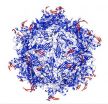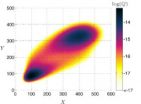(Press-News.org) Rice University scientists have designed a tunable virus that works like a safe deposit box. It takes two keys to open it and release its therapeutic cargo.
The Rice lab of bioengineer Junghae Suh has developed an adeno-associated virus (AAV) that unlocks only in the presence of two selected proteases, enzymes that cut up other proteins for disposal. Because certain proteases are elevated at tumor sites, the viruses can be designed to target and destroy the cancer cells.
The work appears online this week in the American Chemical Society journal ACS Nano.
AAVs are fairly benign and have become the object of intense study as delivery vehicles for gene therapies. Researchers often try to target AAVs to cellular receptors that may be slightly overexpressed on diseased cells.
The Rice lab takes a different approach. "We were looking for other types of biomarkers beyond cellular receptors present at disease sites," Suh said. "In breast cancer, for example, it's known the tumor cells oversecrete extracellular proteases, but perhaps more important are the infiltrating immune cells that migrate into the tumor microenvironment and start dumping out a whole bunch of proteases as well.
"So that's what we're going after to do targeted delivery. Our basic idea is to create viruses that, in the locked configuration, can't do anything. They're inert," she said. When programmed AAVs encounter the right protease keys at sites of disease, "these viruses unlock, bind to the cells and deliver payloads that will either kill the cells for cancer therapy or deliver genes that can fix them for other disease applications."
Suh's lab genetically inserts peptides into the self-assembling AAVs to lock the capsids, the hard shells that protect genes contained within. The target proteases recognize the peptides "and chew off the locks," effectively unlocking the virus and allowing it to bind to the diseased cells.
"If we were just looking for one protease, it might be at the cancer site, but it could also be somewhere else in your body where you have inflammation. This could lead to undesirable side effects," she said. "By requiring two different proteases – let's say protease A and protease B – to open the locked virus, we may achieve higher delivery specificity since the chance of having both proteases elevated at a site becomes smaller."
In the future, molecular-imaging approaches will be used to detect both the identity and concentration of elevated proteases. "With that information, we would be able to pick a virus device from our panel of engineered variants that has the right properties to target that disease site. That's where we want to go," she said.
Suh said elevated proteases are found around many diseased tissues. She suggested these protease-activatable viruses may be useful for the treatment of not only cancers but also neurological diseases, such as stroke, Parkinson's and Alzheimer's diseases, and heart diseases, including myocardial infarction and congestive heart failure.
The ultimate vision of this technology is to design viruses that can carry out a combination of steps for targeting. "To increase the specificity of virus unlocking, you can imagine creating viruses that require many more keys to open," she said. "For example, you may need both proteases A and B as well as a cellular receptor to unlock the virus. The work reported here is a good first step toward this goal."
INFORMATION:
Co-authors are Rice alumni Justin Judd and Abhinav Tiwari; graduate students Michelle Ho, Eric Gomez and Christopher Dempsey; Oleg Igoshin, an associate professor of bioengineering; and Jonathan Silberg, an associate professor of biochemistry and cell biology, all at Rice; and Kim Van Vliet, an assistant research scientist, and Mavis Agbandje-McKenna, a professor, both at the University of Florida. Suh is an assistant professor of bioengineering.
The National Science Foundation, the National Institutes of Health, the American Heart Association and the Cancer Prevention and Research Institute of Texas supported the research.
Read the abstract at http://pubs.acs.org/doi/abs/10.1021/nn500550q
Follow Rice News and Media Relations via Twitter @RiceUNews
Related Materials:
Laboratory for Nanotherapeutics Research (Suh): http://www.owlnet.rice.edu/~js8/
Rice Department of Bioengineering: http://bioe.rice.edu
Located on a 300-acre forested campus in Houston, Rice University is consistently ranked among the nation's top 20 universities by U.S. News & World Report. Rice has highly respected schools of Architecture, Business, Continuing Studies, Engineering, Humanities, Music, Natural Sciences and Social Sciences and is home to the Baker Institute for Public Policy. With 3,920 undergraduates and 2,567 graduate students, Rice's undergraduate student-to-faculty ratio is 6.3-to-1. Its residential college system builds close-knit communities and lifelong friendships, just one reason why Rice has been ranked No. 1 for best quality of life multiple times by the Princeton Review and No. 2 for "best value" among private universities by Kiplinger's Personal Finance.
Two-lock box delivers cancer therapy
Rice University researchers find new possibilities for benign, 'tunable' virus
2014-05-06
ELSE PRESS RELEASES FROM THIS DATE:
Donor livers preserved and improved with room-temperature perfusion system
2014-05-06
A system developed by investigators at the Massachusetts General Hospital (MGH) Center for Engineering in Medicine (CEM) and the MGH Transplant Center has the potential to increase both the supply and the quality of donor organs for liver transplantation. In their report, which has been published online in the American Journal of Transplantation, the research team describes how use of a machine perfusion system delivering a supply of nutrients and oxygen though an organ's circulation at room temperature preserved and improved the metabolic function of donor livers in a ...
Study: Concussion rate in high-school athletes more than doubled in 7-year period
2014-05-06
COLUMBUS, Ohio – Concussion rates in U.S. high-school athletes more than doubled between 2005 and 2012, according to a new national study using data on nine team sports.
Overall, the rate increased from .23 to .51 concussions per 1,000 athlete exposures. An athlete exposure is defined as one athlete participating in one competition or practice.
The increase might appear to sound an alarm about sports safety, but the researchers suspect the upward trend in reported concussions reflects increased awareness – especially because the rates went up the most after the 2008-09 ...
Childhood obesity trends -- not time to celebrate, yet
2014-05-06
New Rochelle, NY, May 6, 2014—Despite reports in the media that the obesity rate among young children has declined dramatically during the past 10 years, that is not the conclusion reached by recent studies published in the medical literature. Those studies did, however, reveal some potentially encouraging findings, which are detailed in the Editorial "Childhood Obesity Trends: Time for Champagne?" published in Childhood Obesity, a peer-reviewed journal from Mary Ann Liebert, Inc., publishers. The article is available free on the Childhood Obesity website at http://www.liebertpub.com/chi.
"The ...
Ban cigarette filters to save the environment, suggest researchers
2014-05-06
Ban cigarette filters. Start a deposit-return scheme for used butts. Hold manufacturers responsible for clean-ups. Place warnings on packets about the impact of simply flicking one's used cigarettes away. These are among the policy measures that Thomas Novotny of the San Diego State University in the US and Elli Slaughter advocate to curb the environmental harm done through the large-scale littering of cigarette butts, packaging and matches. The suggestions are part of a review article in Springer's journal Current Environmental Health Reports.
Cigarette butts and other ...
Neutron star magnetic fields: Not so turbulent, after all?
2014-05-06
Neutron stars, the extraordinarily dense stellar bodies created when massive stars collapse, are known to host the strongest magnetic fields in the universe -- as much as a billion times more powerful than any man-made electromagnet. But some neutron stars are much more strongly magnetized than others, and this disparity has long puzzled astrophysicists.
Now, a study by McGill University physicists Konstantinos Gourgouliatos and Andrew Cumming sheds new light on the expected geometry of the magnetic field in neutron stars. The findings, published online April 29 in Physical ...
Detecting fetal chromosomal defects without risk
2014-05-06
Chromosomal abnormalities that result in birth defects and genetic disorders like Down syndrome remain a significant health burden in the United States and throughout the world, with some current prenatal screening procedures invasive and a potential risk to mother and unborn child.
In a paper published online this week in the Early Edition of PNAS, a team of scientists at the University of California, San Diego School of Medicine and in China describe a new benchtop semiconductor sequencing procedure and newly developed bioinformatics software tools that are fast, accurate, ...
Working to cure 'dry eye' disease
2014-05-06
WASHINGTON D.C. May 6, 2013 -- The eye is an exquisitely sensitive system with many aspects that remain somewhat of a mystery—both in the laboratory and in the clinic.
A U.S.-based team of mathematicians and optometrists is working to change this by gaining a better understanding of the inner workings of tear film distribution over the eye's surface. This, in turn, may lead to better treatments or a cure for the tear film disease known as "dry eye." They describe their work in the journal Physics of Fluids.
Dry eye disease afflicts millions of people worldwide, with ...
Predator-prey made simple
2014-05-06
WASHINGTON D.C. May 6, 2013 -- A team of U.K. researchers has developed a way to dramatically reduce the complexity of modeling "bistable" systems which involve the interaction of two evolving species where one changes faster than the other ("slow-fast systems"). Described in The Journal of Chemical Physics, the work paves the way for easier computational simulations and predictions involving such systems, which are found in fields as diverse as chemistry, biology and ecology.
Imagine, for instance, trying to predict how a population of whales would fare based on the ...
A cup of coffee a day may keep retinal damage away
2014-05-06
ITHACA, N.Y. – Coffee drinkers, rejoice! Aside from java's energy jolt, food scientists say you may reap another health benefit from a daily cup of joe: prevention of deteriorating eyesight and possible blindness from retinal degeneration due to glaucoma, aging and diabetes.
Raw coffee is, on average, just 1 percent caffeine, but it contains 7 to 9 percent chlorogenic acid, a strong antioxidant that prevents retinal degeneration in mice, according to a Cornell study published in the Journal of Agricultural and Food Chemistry.
The retina is a thin tissue layer on the ...
Expert guidance strengthens strategies to prevent most common and costly infection
2014-05-06
CHICAGO (May 6, 2014) – Surgical site infections (SSIs) are the most common and costly healthcare-associated infection (HAI) in the United States. New evidence-based recommendations provide a framework for healthcare institutions to prioritize and implement strategies to reduce the number of infections.
The guidelines are published in the June issue of Infection Control and Hospital Epidemiology and were produced in a collaborative effort led by the Society for Healthcare Epidemiology of America, the Infectious Diseases Society of America, the American Hospital Association, ...
LAST 30 PRESS RELEASES:
Climate extremes triggered rare coral disease and mass mortality on the Great Barrier Reef
Direct observation reveals “two-in-one” roles of plasma turbulence
Humans rank between meerkats and beavers in monogamy ‘league table’
US fossil reveals early mass-burial event and ancient microbial attack
Sedative choice could improve outcomes for breathing tube patients
New superconducting thin film for quantum computer chips
Simulations reveal protein "dynamin" constricts cell membranes by loosening its grip
Nearly 1 in 5 UK emergency department patients cared for in corridors/waiting rooms
Heavy energy drink intake may pose serious stroke risk, doctors warn
Violence against women and children among top health threats: New global study reveals disease burden far larger than previously estimated
Predicting who is at risk of developing type 1 diabetes, as new drugs now available
New gene-mapping method unlocks hidden drivers of cancer
Ocean current and seabed shape influence warm water circulation under ice shelves
Call to increase funding for ‘invisible’ Deaf victim-survivors of domestic abuse
University of Maryland School of Medicine names distinguished scientist and academic leader Gerald M. Wilson, PhD, as Chair of the Department of Biochemistry and Molecular Biology
Receptors in mammary glands make livestock and humans inviting hosts for avian flu
Icy hot plasmas
Treating adults with autism: Maryland Clinical Center offers national blueprint for care after pediatric transition
University of Phoenix College of Doctoral Studies releases white paper on reclaiming control to build workforce resilience
NCCN Summit seeks to improve care for veterans and first responders with cancer from line-of-duty exposure
ERC Consolidator Grant for soft robotics researcher
Dual-action arts and wellbeing program transforms dementia care
The global plastic waste trade contributes to coastal litter in importing countries, study shows
UT Dallas partners with Tech Mahindra on AI innovation
Blinking less could signal the brain is working harder to listen, Concordia study shows
Male bonobos track females’ reproductive cycle to maximize mating success
New report outlines science priorities for human Mars exploration
Want to curb cannabis-related crashes? Don’t forget older adults, study finds
Expectant management vs medication for patent ductus arteriosus in preterm infants
Pew funds 7 new biomedical research collaborations
[Press-News.org] Two-lock box delivers cancer therapyRice University researchers find new possibilities for benign, 'tunable' virus




